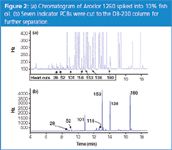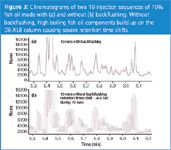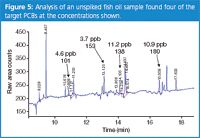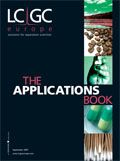Direct Injection of Fish Oil for the GC–ECD Analysis of PCBs: Results Using a Deans Switch with Backflushing
The Application Notebook
A Deans switch, employing Agilent's Capillary Flow Technology, was configured on an Agilent 7890A GC equipped with dual ECD detectors. A method was developed for the analysis of fish oil for PCB contamination. The Deans switch was used to heart cut 7 indicator PCBs (IUPAC Numbers 28, 52, 101, 118, 138, 153 and 180) from the primary DB-XLB column on to a DB-200 column for further separation. Fish oil from a supplement capsule was simply diluted 1:10 in isooctane and injected directly. To prevent carryover, contamination and retention time shifts, the Deans switch was used to backflush the primary column at the end of each run.
Fish oils contain high levels of eicosapentanoic acid (EPA) and docosahexanoic acid (DHA), omega-3 fatty acids that are thought to have beneficial health affects. Many people take fish oil as a supplement to their daily diet. For quality assurance, it is necessary to analyse fish oil for PCB contamination. Analysis is complicated by the fact that fish oil is a very complex mixture that contains high boiling fatty acids, triglycerides, phospholipids, glycerol ethers, wax esters and fatty alcohols. PCB analysis is complex by itself, with 209 possible congeners. Of these, 140–150 have been observed in commercial PCB mixtures called Aroclors and no single GC column or method separates them all.
This paper describes a method for the analysis of the seven indicator PCBs in fish oil using an Agilent 7890A GC configured with a Deans switch, two columns of differing selectivity and dual electron capture detectors (ECDs). Fish oil from commercially available supplements was simply diluted 10:1 in isooctane and injected into the GC. No clean up steps were employed.

Results and Discussion
The Deans switch (Figure 1) is one of Agilent's new devices that employ capillary flow technology. All of them have extremely low dead volumes, are inert and do not leak, even with large cycles in oven temperature. Their low thermal mass eliminates peak tailing from temperature lag during programmed runs. The inset in Figure 1 shows a Deans switch mounted on the 7890A GC oven wall.

Figure 1
The DB-XLB column is connected between the split/splitless inlet and the middle port of the Deans switch (Figure 1). A short length of deactivated fused silica tubing connects the Deans switch to the front ECD. A DB-200 was chosen as the secondary column because it is more polar than the DB-XLB column and has a different selectivity for PCBs. Its upper temperature limit of 300 °C is high enough to elute all the PCBs of interest.
The blue arrows in Figure 1 show the direction of flows when the solenoid valve is in the off position. In this mode, the effluent from the primary DB-XLB column is swept through the restrictor to the front ECD. When the solenoid valve is switched (red arrows), the effluent is directed through the secondary DB-200 column to the back ECD. Retention times for the seven indicator PCBs were initially determined with the valve in the off position. Using the timed events table in the ChemStation, the valve was switched to on just before each PCB peak and off immediately after. This produced seven heart cuts that were directed through the DB-200 column to the back ECD.
Figure 2(a) shows the chromatogram for a fish oil sample spiked with Aroclor 1260. PCBs 28, 52, 101, 118, 138, 153 and 180 were cut out of the primary chromatogram and sent to the second column [Figure 2(b)]. The purpose of the DB-200 column is to resolve the target PCBs from other PCBs and matrix components that co-elute with them on the DB-XLB column.

Figure 2
Without backflushing, the high boiling components of fish oil can be retained by the GC column causing severe carryover problems from one run to the next. After a few injections, so much of the fish oil residue builds up on the column that it causes PCB retention times to shift by several seconds. Because the PCB heart cuts are only 5–6 sec wide, any shift in RT means the intended PCB peak is missed.
Figure 3 shows the difference in two sequences of fish oil injections — one made with backflushing [Figure 3(a)] and one made without backflushing [Figure 3(b)].

Figure 3
RT shifts on column 1 [Figure 3(b)] have a dramatic affect on the heart cut PCB areas as illustrated in Figure 4. With backflushing the area count precision for PCBs 118 and 153 is excellent. Without backflushing, the target PCBs move out of the heart cut window and area counts fall off rapidly.

Figure 4

Figure 5
Six of the 7 PCBs were calibrated from 0.1–100 ppb. PCB 28 was calibrated from 1–100 ppb. The analysis of one unspiked fish oil sample revealed four of the target PCBs with a total concentration of 40.4 ppb (Figure 5). These four PCBs were detected in the diluted sample at 0.46, 1.37, 1.12 and 1.09 ppb. Accounting for the 10-fold dilution gives the PCB concentrations shown. The Council for Responsible Nutrition, an industry trade group,1 recommends that the sum of the seven indicator PCB concentrations be less than 0.09 mg/Kg (90 ppb).
Conclusions
This paper demonstrates that it is possible to analyse PCBs in fish oil without performing laborious sample clean up prior to GC injection. PCBs 52, 101, 118, 138, 153 and 180 could be quantified at 1 ppb in undiluted fish oil. PCB 28 could be quantified at 10 ppb.
Philip L. Wylie, Agilent Technologies Inc., Wilmington, Delaware, USA.
References
1. "Voluntary Monograph: Omega-3 DHA, Omega 3 EPA, Omega-3 DHA and EPA", Council for Responsible Nutrition, http://www.crnusa.org/pdfs/O3FINALMONOGRAPHdoc.pdf

Agilent Technologies Inc.
2850 Centerville Road, Wilmington, Delaware 19808-1610, USA
tel. +1 302 633 8416 fax +1 302 993 5969
E-mail: phil_wylie@agilent.com Website: www.chem.agilent.com

Analytical Challenges in Measuring Migration from Food Contact Materials
November 2nd 2015Food contact materials contain low molecular weight additives and processing aids which can migrate into foods leading to trace levels of contamination. Food safety is ensured through regulations, comprising compositional controls and migration limits, which present a significant analytical challenge to the food industry to ensure compliance and demonstrate due diligence. Of the various analytical approaches, LC-MS/MS has proved to be an essential tool in monitoring migration of target compounds into foods, and more sophisticated approaches such as LC-high resolution MS (Orbitrap) are being increasingly used for untargeted analysis to monitor non-intentionally added substances. This podcast will provide an overview to this area, illustrated with various applications showing current approaches being employed.









